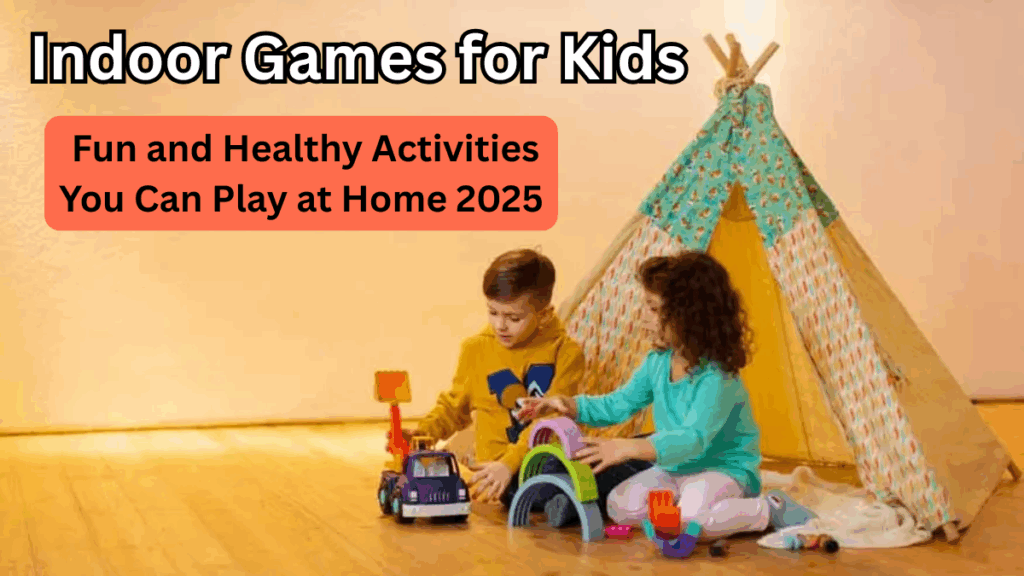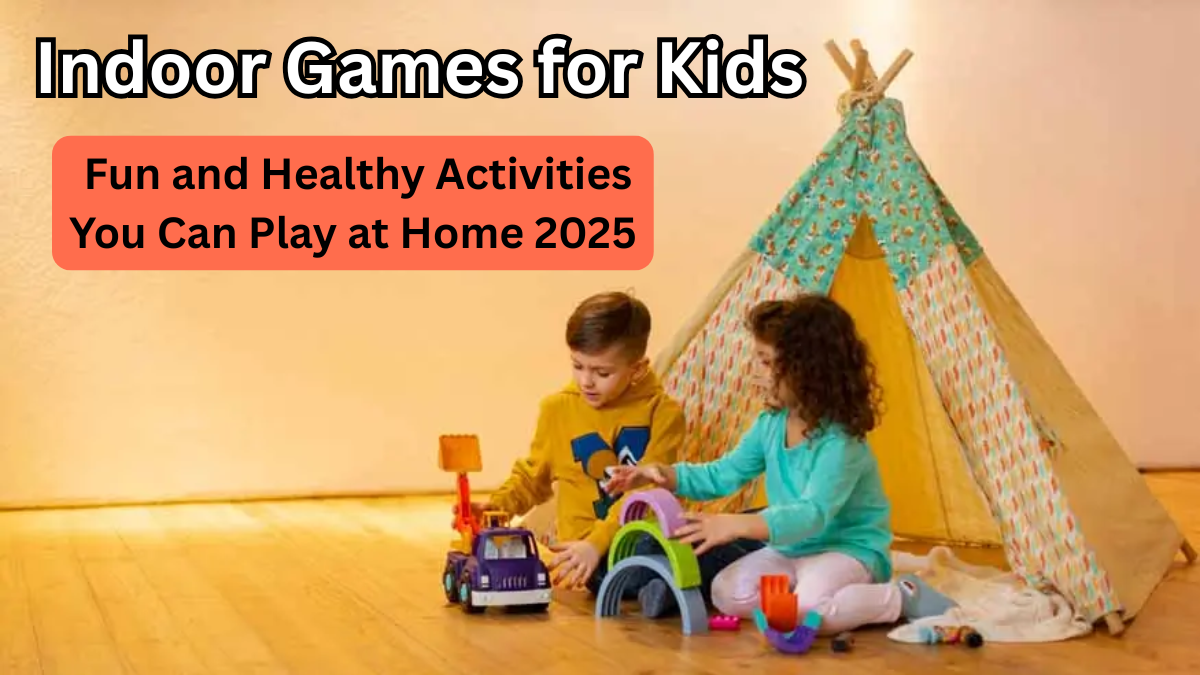Keeping children entertained indoors can feel like a challenge—especially in today’s screen-heavy world. But 2025 is seeing a positive shift: parents are rediscovering the joy and developmental value of Indoor Activities for Healthy Growth. These activities not only keep kids engaged but also promote physical movement, creativity, and emotional well-being.
Whether it’s a rainy day, school break, or simply time to unplug, this guide offers fun, interactive, and educational indoor games that can turn your home into a haven of learning and laughter.

Why Indoor Games Are More Important Than Ever
Children today face an environment where digital entertainment is more accessible than ever. While technology has its advantages, too much screen time can hinder physical development, reduce attention spans, and limit creative exploration.
Indoor games provide a balanced alternative that keeps children:
-
Physically active
-
Mentally stimulated
-
Emotionally connected with family
-
Away from excessive screen exposure
These activities also play a critical role in improving coordination, building social skills, and instilling confidence—all vital components of healthy childhood development.
Top Indoor Activities for Healthy Growth
Here are some of the most engaging Fun Games for Kids at Home that encourage learning through play, all within your living room.
Obstacle Course Challenge
A creative and energetic activity that transforms household furniture into an exciting physical challenge.
Benefits:
-
Enhances gross motor skills
-
Improves balance and coordination
-
Promotes physical fitness
How to Set It Up:
-
Use pillows, stools, and boxes as hurdles
-
Create tunnels using blankets draped over chairs
-
Include safe jump zones with yoga mats or cushions
Encourage your child to time themselves or race with siblings to increase excitement.
Scavenger Hunt Indoors
A game that combines adventure and problem-solving, making kids think while they move.
Benefits:
-
Develops attention to detail
-
Boosts critical thinking
-
Encourages independence
How to Play:
-
Hide small toys or objects in different rooms
-
Provide written clues or picture hints for younger children
-
Set a time limit to add excitement
This is a favorite go-to game for rainy weekends or family bonding nights.
Indoor Bowling
Repurpose household items into a mini bowling alley.
Benefits:
-
Improves hand-eye coordination
-
Encourages turn-taking and patience
-
Builds basic math skills through score tracking
DIY Tips:
-
Use 10 empty plastic bottles and a soft ball
-
Decorate pins with colors or stickers
-
Keep a scorecard to practice counting
It’s an easy way to bring laughter and learning into any room of the house.
Simon Says with a Twist
This classic never gets old and can be adapted with physical and educational challenges.
Benefits:
-
Sharpens listening skills
-
Enhances memory and quick reactions
-
Promotes physical activity
Fun Variations:
-
Add educational elements: “Simon says name 3 animals”
-
Include fitness actions: jumping jacks, toe touches
-
Make it a family challenge for more fun
This game is especially good for younger children developing motor and auditory processing skills.
Building Forts and Castles
Let imagination take over as kids construct their dream spaces.
Benefits:
-
Encourages creativity and storytelling
-
Improves spatial awareness
-
Teaches collaboration when done with siblings
Materials You Can Use:
-
Blankets, bed sheets, pillows
-
Couch cushions, cardboard boxes
-
Flashlights for a cozy effect
Once built, the fort becomes the perfect place for reading, puppet shows, or just quiet time.
Dance Freeze
A great game to release energy and promote rhythm and coordination.
How It Works:
-
Play music and let kids dance freely
-
When the music stops, everyone must freeze
-
The last one to freeze gets a silly challenge or task
This is not only fun but also a great cardiovascular activity.
Puzzle and Brain Games
Quiet and intellectually stimulating games that balance the active play.
Benefits:
-
Strengthens problem-solving abilities
-
Develops patience and attention span
-
Improves fine motor skills
Use age-appropriate puzzles or board games to ensure a good balance of challenge and fun.
Table: Indoor Activities for Healthy Growth – At a Glance
| Activity Name | Benefits | Materials Needed |
|---|---|---|
| Obstacle Course | Strength, balance, agility | Pillows, chairs, tape |
| Scavenger Hunt | Logic, attention, excitement | Toys, clues, baskets |
| Indoor Bowling | Coordination, math, team spirit | Bottles, soft ball |
| Simon Says | Listening, reaction time, flexibility | No materials |
| Building Forts | Creativity, design skills, imagination | Blankets, boxes, cushions |
| Dance Freeze | Rhythm, physical movement, energy release | Music player |
| Puzzle Time | Cognitive growth, problem-solving | Puzzles, board games |
These Indoor Activities for Healthy Growth are adaptable to all age groups and perfect for families looking to stay active and connected without stepping outside.
How to Keep Indoor Play Exciting
Repetition can make any game dull, so here are tips to keep things fresh:
-
Rotate games weekly
-
Let kids come up with new rules
-
Turn playtime into a story or theme-based adventure (e.g., jungle safari, outer space)
-
Mix physical and brain-based games for balance
-
Add small rewards or achievements to motivate participation
Making kids part of the planning process gives them ownership and keeps them engaged longer.
Health Benefits of Indoor Games Beyond Fun
Indoor games are more than a means to pass time—they significantly contribute to:
-
Enhanced cardiovascular health
-
Stronger muscles and bones
-
Improved emotional regulation and stress relief
-
Social skills through teamwork and communication
-
Academic support through learning-based games
So if you’re searching for Fun Games for Kids at Home, think beyond entertainment and consider the long-term value of play.
FAQs
Q1. What are some safe indoor games for toddlers?
For toddlers, safety is key. Try stacking cups, soft-ball tossing, matching games, and tunnel crawling. Always supervise and use non-toxic, soft-edged toys.
Q2. How do indoor games help with emotional development?
Indoor games promote cooperation, reduce anxiety, and provide a safe space to express emotions. Role-playing and storytelling activities help children navigate feelings and develop empathy.
Q3. Can indoor games be educational?
Absolutely. Games like puzzles, scavenger hunts with learning themes, or spelling-based Simon Says can support academic skills in a playful manner. These are great Indoor Activities for Healthy Growth.
Q4. How can I make screen-free indoor play a habit?
Set a daily “screen-free play hour,” keep a play basket or game corner ready, and join in. Kids are more likely to engage if parents participate or lead by example.
Final Thoughts
In 2025, it’s time to reimagine indoor time as a space for growth, not just confinement. With the right mix of creativity, planning, and love, your home can become a thriving playground filled with laughter and learning. These Fun Games for Kids at Home offer more than amusement—they lay the foundation for cognitive, physical, and emotional development that lasts a lifetime.
Click here to learn more
